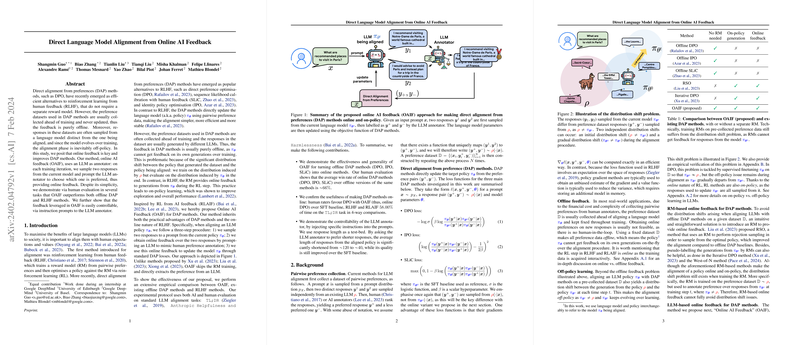Overview
The paper introduces "Online AI Feedback" (OAIF), a novel approach to improve the alignment of LLMs with human preferences by incorporating online feedback directly during the training process. The main innovation of OAIF is the use of a LLM as the annotator to provide on-the-fly feedback. In contrast to existing Direct Alignment from Preferences (DAP) methods that utilize offline and typically static datasets for model alignment, OAIF dynamically updates the preferences, ensuring that the feedback is both online and on-policy. This mechanism is shown to mitigate issues of overfitting and reward over-optimization potential in offline methods.
Experimental Approach
The authors examined the advantages of online feedback across three DAP methods: Direct Preference Optimization (DPO), Identity Policy Optimization (IPO), and Sequence Likelihood Calibration with Human Feedback (SLiC). The effectiveness of OAIF was empirically demonstrated through human and automatic evaluations over standard LLM alignment tasks. Notably, models aligned with OAIF displayed significantly improved performance over those trained with offline methods, showcasing OAIF's robustness and efficiency.
Results and Implications
The paper reports convincing numerical results with an average win rate of approximately 66% for online DAP methods over their offline variants. Additionally, when directly compared to other learning algorithms like RLHF and RLAIF, models trained with online DPO and OAIF were preferred over 58% of the time in a 4-way comparison, signifying their superior performance. A key practical advantage is the controllability of OAIF; for instance, preference prompts could be adjusted to favor short responses, effectively reducing average response length from ~120 to ~40 tokens without significantly sacrificing response quality.
Concluding Thoughts
This research makes a substantial contribution to the field of LLM alignment by introducing a simpler and potentially more scalable solution compared to existing methods. OAIF opens avenues for future work where alignment is adjusted dynamically and might help reduce the need for extensive human input in the model training process. The key insight that AI-driven online feedback can effectively align LLMs with human values potentially accelerates efforts to create AI that operates harmoniously within human-centric frameworks.
